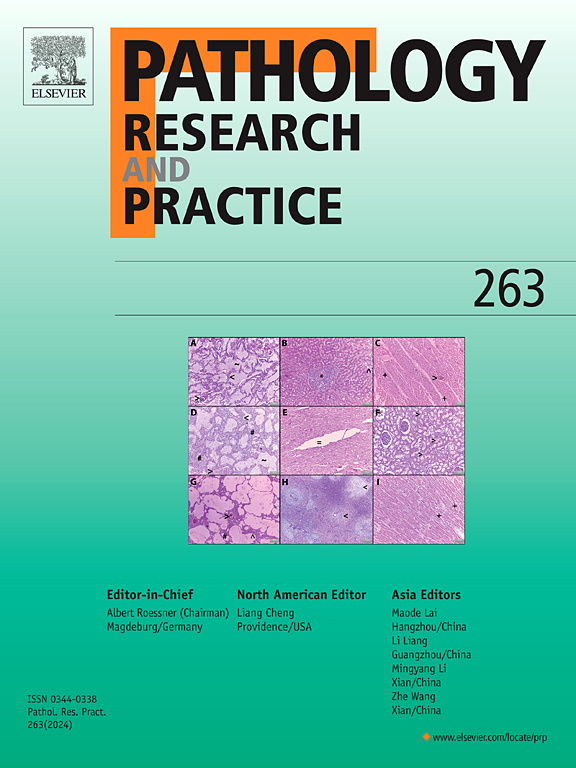USP41通过Notch1激活调节胶质瘤恶性:来自体外和体内研究的见解
IF 3.2
4区 医学
Q2 PATHOLOGY
引用次数: 0
摘要
神经胶质瘤是最常见和致命的原发性成人中枢神经系统肿瘤,尽管有广泛的研究,但治疗进展有限。泛素-蛋白酶体系统(UPS),特别是泛素特异性蛋白酶(USPs),在肿瘤发生中起着关键作用。USP41是USP家族的一员,与多种癌症类型有关,但其在胶质瘤中的功能尚不清楚。本研究旨在探讨USP41在胶质瘤细胞和组织中的表达、生物学功能及潜在的分子机制,为胶质瘤的靶向治疗提供依据。方法采用qPCR和Western blotting检测临床胶质瘤标本、正常脑组织和细胞系中sus41的表达水平。利用GEPIA数据库和KEGG富集进行生物信息学分析,以确定相关的信号通路。功能测定包括CCK-8、EdU、菌落形成、Transwell迁移/侵袭、伤口愈合、流式细胞术和异种移植物模型,用于评估增殖、迁移、侵袭、细胞凋亡和肿瘤生长。Notch1信号在usp41介导的胶质瘤调节中的作用通过药理激活评估(Jagged-1)。结果sus41在胶质瘤组织和细胞系中表达上调,并与较差的生存率相关。USP41敲低显著抑制胶质瘤细胞的增殖、迁移、侵袭和上皮间质转化(EMT),同时促进细胞凋亡。在体内,敲除USP41可减小肿瘤的大小和重量。机制研究表明USP41通过Notch1途径促进胶质瘤的进展。结论sus41通过Notch1信号通路调控胶质瘤的生长和侵袭性。靶向USP41可能是一种有希望改善胶质瘤预后的治疗策略。本文章由计算机程序翻译,如有差异,请以英文原文为准。
USP41 regulates glioma malignancy through Notch1 activation: Insights from in vitro and in vivo studies
Background
Glioma is the most prevalent and lethal primary adult central nervous system tumor, with limited therapeutic advances despite extensive research. The ubiquitin-proteasome system (UPS), particularly ubiquitin-specific proteases (USPs), plays critical roles in tumorigenesis. USP41, a member of the USP family, is implicated in multiple cancer types, but its function in glioma remains poorly understood. This study aimed to investigate the expression, biological functions, and underlying molecular mechanisms of USP41 in glioma cells and tissues, providing insights for targeted therapies.
Methods
USP41 expression levels were examined in clinical glioma specimens, normal brain tissues, and cell lines using qPCR and Western blotting. Bioinformatics analysis was conducted using the GEPIA database and KEGG enrichment to identify related signaling pathways. Functional assays, including CCK-8, EdU, colony formation, Transwell migration/invasion, wound healing, flow cytometry, and a xenograft model, were employed to evaluate proliferation, migration, invasion, apoptosis, and tumor growth. The role of Notch1 signaling in USP41-mediated glioma regulation was assessed through pharmacological activation (Jagged-1).
Results
USP41 expression was upregulated in glioma tissues and cell lines and associated with poorer survival. USP41 knockdown significantly inhibited glioma cell proliferation, migration, invasion, and epithelial-mesenchymal transition (EMT), while promoting apoptosis in vitro. In vivo, USP41 knockdown reduced tumor size and weight. Mechanistic studies suggested that USP41 enhances glioma progression via the Notch1 pathway.
Conclusions
USP41 is a key regulator of glioma growth and invasiveness through Notch1 signaling. Targeting USP41 may represent a promising therapeutic strategy for improving glioma outcomes.
求助全文
通过发布文献求助,成功后即可免费获取论文全文。
去求助
来源期刊
CiteScore
5.00
自引率
3.60%
发文量
405
审稿时长
24 days
期刊介绍:
Pathology, Research and Practice provides accessible coverage of the most recent developments across the entire field of pathology: Reviews focus on recent progress in pathology, while Comments look at interesting current problems and at hypotheses for future developments in pathology. Original Papers present novel findings on all aspects of general, anatomic and molecular pathology. Rapid Communications inform readers on preliminary findings that may be relevant for further studies and need to be communicated quickly. Teaching Cases look at new aspects or special diagnostic problems of diseases and at case reports relevant for the pathologist''s practice.

 求助内容:
求助内容: 应助结果提醒方式:
应助结果提醒方式:


